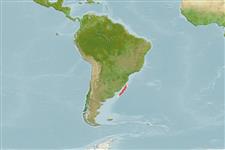Élasmobranches (requins et raies) (sharks and rays) >
Carcharhiniformes (Ground sharks) >
Scyliorhinidae (Cat sharks) > Scyliorhininae
Etymology: Scyliorhinus: skylion, Greek for dogfish or small shark; rhinus, from rhine (Gr.), rasp, alluding to a shark’s jagged, rasp-like skin (See ETYFish).
Eponymy: Professor Wladimir Besnard (1890–1960) was the founder and first Director of Instituto Oceanografico da Universidade de Sao Paulo. [...] (Ref. 128868), visit book page.
Issue
Junior synonym of Scyliorhinus haeckelii according to Soares et al. 2019 (Ref. 120402). This species summary page will be deleted.
Environment: milieu / climate zone / depth range / distribution range
Écologie
marin démersal; profondeur 140 - 190 m. Subtropical; 31°S - 39°S
Southwest Atlantic: Brazil and northern Uruguay.
Taille / Poids / Âge
Maturity: Lm ? range ? - ? cm
Max length : 47.0 cm TL mâle / non sexé; (Ref. 244)
Found on the outer continental shelf. Oviparous (Ref. 50449).
Life cycle and mating behavior
Maturité | Reproduction | Frai | Œufs | Fécondité | Larves
Compagno, L.J.V., 1984. FAO Species Catalogue. Vol. 4. Sharks of the world. An annotated and illustrated catalogue of shark species known to date. Part 2 - Carcharhiniformes. FAO Fish. Synop. 125(4/2):251-655. Rome: FAO. (Ref. 244)
Statut dans la liste rouge de l'IUCN (Ref. 130435: Version 2024-1)
Menace pour l'homme
Harmless
Utilisations par l'homme
Pêcheries: sans intérêt
Outils
Articles particuliers
Télécharger en XML
Sources Internet
Estimates based on models
Preferred temperature (Ref.
123201): 11.5 - 19.6, mean 16 °C (based on 10 cells).
Phylogenetic diversity index (Ref.
82804): PD
50 = 0.5000 [Uniqueness, from 0.5 = low to 2.0 = high].
Bayesian length-weight: a=0.00263 (0.00138 - 0.00502), b=3.21 (3.04 - 3.38), in cm total length, based on LWR estimates for this (Sub)family-body shape (Ref.
93245).
Niveau trophique (Ref.
69278): 3.8 ±0.5 se; based on size and trophs of closest relatives
Résilience (Ref.
120179): Faible, temps minimum de doublement de population : 4,5 à 14 années (Fec assumed to be <100).
Fishing Vulnerability (Ref.
59153): Moderate vulnerability (37 of 100).
Nutrients (Ref.
124155): Calcium = 34.1 [4.9, 187.5] mg/100g; Iron = 0.864 [0.237, 2.666] mg/100g; Protein = 18.2 [15.1, 21.3] %; Omega3 = 0.215 [0.094, 0.467] g/100g; Selenium = 20.1 [5.8, 58.5] μg/100g; VitaminA = 19.8 [6.9, 56.4] μg/100g; Zinc = 0.594 [0.281, 1.116] mg/100g (wet weight);
